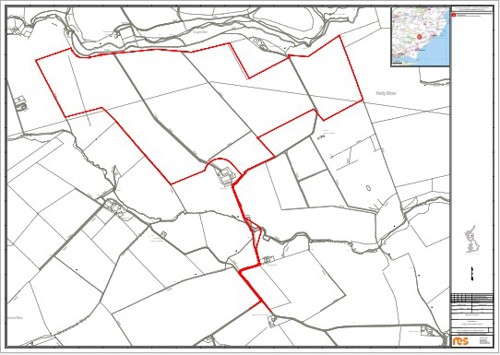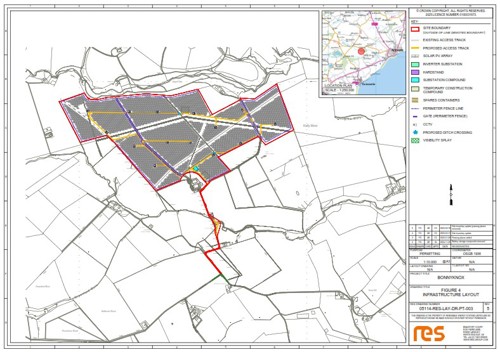Planning application
In May 2025, RES submitted a planning application for the 49.9MW Bonnyknox Solar Farm, on land at Fallaws Farm, Arbirlot, approximately 5km west of Arbroath.
The planning application was validated by Angus Council in July 2025, and can be viewed on the planning portal here using the reference 25/00339/FULM. Electronic copies of the planning application and accompanying documents can be viewed or downloaded by clicking on the links below.
Planning Design and Access Statement
Pre-Application Consultation (PAC) report
Figures
-
- Figure 1 - Site Location Plan
- Figure 2 - Site Location Map
- Figure 3 - Field Numbers
- Figure 4 - Infrastructure Layout
- Figure 5 - Infrastructure Layout Enlargement
- Figure 6 - Typical Access Track Detail
- Figure 7 - Typical Temporary Construction Compound
- Figure 8 - Typical PV Module and Rack Detail
- Figure 9 - Typical Security Fence Detail
- Figure 10 - Typical Security CCTV Detail
- Figure 11 - Typical Deer Fence Detail
- Figure 12 - Typical Inverter Substation
- Figure 13 - DNO Substation Plan and Elevations
Agricultural Land Classification
Arboricultural Impact Assessment
Preliminary Ecological Assessment Report
Flood Risk Assessment and Drainage Impact Assessment
Landscape and Visual Assessment (LVA)
-
- Appendix C: Photomontages (split below)
Transport Statement - Including Construction Traffic Management Plan (CTMP)
Reasons to support the Bonnyknox Solar Farm proposal
Solar is one of the cheapest sources of new electricity generation, and therefore will play a key role in improving Scotland’s energy security, while supporting the transition away from fossil fuels. Angus is also one of the sunniest places in Scotland, making it ideal for solar farms.
As Scotland strives to be a net-zero carbon economy by 2045, solar is not just an option, it is a necessity as part of a balanced energy mix. Solar is a great resource to assist in this transition as it is free and an inexhaustible resource.
Our current power system still relies heavily on fossil fuels, such as gas. The volatile price of these is the reason that bills have increased so rapidly in recent months. The need to rapidly scale up home grown energy has become even more urgent.
Solar energy enables electricity generation without reliance on imports and is not subject to sudden price fluctuations or the uncertainty of global markets. Alongside other renewable technologies, solar is now the cheapest source of electricity generation.
Solar is a free and inexhaustible resource which has an important role to play as part of a balanced energy mix. If consented, Bonnyknox Solar Farm would be capable of producing clean, green electricity for approximately 15,0001 homes every year, and is estimated to save around 30,000 tonnes of CO2 emissions2 compared to the equivalent fossil fuel generation, every year.
Following conversations with members of the community, our proposal includes plans to install new water pipes around the perimeter of the solar farm, replacing the current private water supplies serving two of the site neighbours. This will safeguard the water supply access for these properties, and improve the quality of the pipes by upgrading them from clay to plastic. This improvement will not only support the needs of the project but also provide long-term benefits to the surrounding community by modernising essential utilities.
As part of the proposal, we are also committed to enhancing the local road network around the site. This includes plans for indicative passing places on public roads, along with further upgrades to the private road network serving nearby properties, all of which will be discussed with the local authority should the project receive consent. These significant improvements have been directly informed by community feedback, offering additional benefits to the local area.
The Bonnyknox Solar Farm proposal includes a comprehensive Landscape and Ecological Management Plan. The measures within this plan would not only reduce potential visibility of the solar farm but also provide wildlife corridors and vital resources for mammals, birds, and insect species.
A detailed Land Classification for Agriculture Report (LCCA) accompanies the planning application and determined that 48.9% of the site is Class 2, 50% Class 3.1, and 1.1% non-agricultural land. Soil classification can be influenced by farming practices, for example potato cultivation at this site, which alters topsoil depth and can artificially elevate land grades.
The Proposed Development has been designed as a dual-purpose development, integrating renewable energy with sheep farming. This supports rural employment, strengthens local economies, and creates a more diverse ecological landscape. Grazing sheep help maintain habitats for wildlife while continuing food production.
Moreover, where solar farms replace intensively farmed land, they allow the soil to regenerate while providing a stable income for farmers. By improving soil quality, solar farms contribute to the availability of high-quality agricultural land for future generations.
The solar farm could deliver direct benefit to the area – generating jobs during construction and decommissioning. Inward investment can be significant as a range of services will be required including haulage, on-site welfare facilities, refuse and recycling facilities, transport and local accommodation for construction workers. In addition, the solar farm would deliver a Community Benefit fund, helping to fund local initiatives and projects.
If, having read the above, you would like to support the project, or submit any kind of representation, you can do so by submitting a comment online via the Angus Council planning portal. The planning reference is 25/00339/FULM and should be included in all correspondence.
1 The homes figure has been calculated by taking the predicted annual electricity generation of the site (using an average solar capacity factor of 11.2%) and dividing this by the annual average electricity figures from DESNZ showing that the annual GB average domestic household consumption is 3,239 kWh (January 2024).
2 RES uses DESNZ’s “all non-renewable fuels” emissions statistic of 424 tonnes of carbon dioxide per GWh of electricity supplied in the Digest of UK Energy Statistics (July 2023) Table 5.14 (“Estimated carbon dioxide emissions from electricity supplied”) to calculate carbon reduction. Carbon reduction is calculated by multiplying the total amount of electricity generated by the solar farm per year by the number of tonnes of carbon which fossil fuels would have produced to generate the same amount of electricity.


